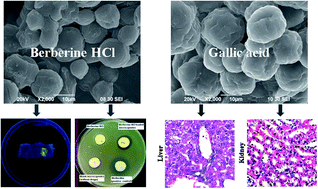Development of formaldehyde-free agar/gelatin microcapsules containing berberine HCl and gallic acid and their topical and oral applications
Abstract
The safety issues of biomedical applications have been a major concern in recent years.

* Corresponding authors
a
Institute of Textiles and Clothing, The Hong Kong Polytechnic University, Hong Kong, China
E-mail:
chchui@graduate.hku.hk
Fax: +852 2637 5396
Tel: +852 2632 3120
b School of Biomedical Science, The Chinese University of Hong Kong, Hong Kong, China
c
Department of Medicine and Therapeutics, Prince of Wales Hospital, The Chinese University of Hong Kong, Hong Kong, China
E-mail:
rsmwong@hotmail.com
Fax: +852 2637 5396
Tel: +852 2635 1500
d Research and Development Division, School of Chinese Medicine, The Baptist University of Hong Kong, Hong Kong, China
e Department of Applied Biology and Chemical Technology, The Hong Kong Polytechnic University, Hong Kong, China
f
BioPharmaNet, Department of Biochemistry and Molecular Biology, The University of Ferrara, Ferrara, Italy
E-mail:
gam@unife.it
Fax: +39-532-202723
Tel: +39-532-974443
The safety issues of biomedical applications have been a major concern in recent years.

 Please wait while we load your content...
Something went wrong. Try again?
Please wait while we load your content...
Something went wrong. Try again?
P. Lam, K. K. Lee, S. H. Kok, G. Y. Cheng, X. Tao, D. K. Hau, M. C. Yuen, K. Lam, R. Gambari, C. Chui and R. S. Wong, Soft Matter, 2012, 8, 5027 DOI: 10.1039/C2SM07236J
To request permission to reproduce material from this article, please go to the Copyright Clearance Center request page.
If you are an author contributing to an RSC publication, you do not need to request permission provided correct acknowledgement is given.
If you are the author of this article, you do not need to request permission to reproduce figures and diagrams provided correct acknowledgement is given. If you want to reproduce the whole article in a third-party publication (excluding your thesis/dissertation for which permission is not required) please go to the Copyright Clearance Center request page.
Read more about how to correctly acknowledge RSC content.
 Fetching data from CrossRef.
Fetching data from CrossRef.
This may take some time to load.
Loading related content
